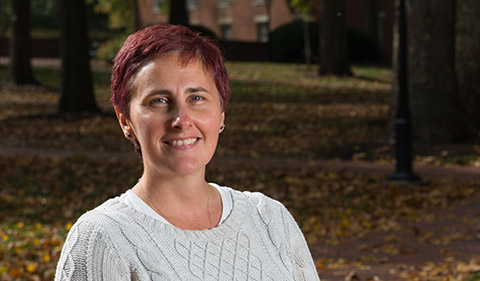
Molly Bukky
Molly Bukky ‘08M, Visiting Assistant Professor of Sociology, presents “Urban and Rural Adolescent Drug Use and Its Relationship with Classic Criminological Theory” at the North Central Sociological Association annual meeting this month in Indianapolis, Indiana.
After graduating with her M.A. in Sociology from the College of Arts and Sciences at Ohio University with concentrations in Social Inequality and Sociology of Education, Bukky went on to doctoral study at The Ohio State University with concentrations in Rural Poverty, Spatial Inequality, Social Problems, Law and Society. She defends her thesis this spring!
Her Master’s thesis was “Move to the Head of the Class: Teacher Agency in Constructing Student Roles in Rural Elementary School;” her Doctoral thesis is the title of her presentation this month, “Urban and Rural Adolescent Drug Use and Its Relationship with Classic Criminological Theory.”
The North Central Sociological Association (NCSA) is a regional sociology association including: Eastern Illinois, Indiana, Michigan, Ohio, Kentucky, Western Pennsylvania, West Virginia and Ontario, Canada. The objectives of the NCSA are to further the development of sociology as a scientific and scholarly discipline through stimulation and promotion of (1) scientific research in its defined subject matter area; (2) the widest possible and feasible utilization of the knowledge and skills of sociologists and the findings of scientific sociological research by public and private agencies in all relevant social policy issues; (3) effective teaching of the subject matter at all levels of educational endeavor; and (4) interchange and cooperative relations among persons and organizations engaged in the scientific study of society; any and all such other acts as may be deemed conductive to these ends.
Abstract:
Despite the long-standing efforts of the war on drugs, drug abuse continues to be a significant social problem in the United States. Understanding the roots of these problems and the mechanisms through which they are transmitted is critical if we hope to find solutions. Drug use behaviors often debut in adolescence and because the brain is still developing, adolescents are at greater risk than adults for developing addiction problems, which may lead to persistent drug abuse behaviors in adulthood.
Three classic criminological theories are often used to explain adolescent drug use behaviors. These theories include strain theory, which proposes that when stress accumulates, especially over a relatively short time, it can increase the propensity towards drug use. Social learning theory is the next theory and it indicates that we learn drug use behaviors from those who we spend the most time around, including our family, close friends and neighbors. Social control theory is the final theory and it proposes that when adolescents have strong bonds with family, friends and the community, they are less likely to use drugs but when those bonds are weak, they are more likely to use drugs. These theories have typically focused on marijuana and other illicit drugs and primarily focused on urban residents. Since the beginning of the twenty-first century, new trends in drug use attitudes and behaviors have emerged, especially the increased prevalence of prescription drug misuse and the decriminalization and legalization of marijuana and it is therefore important to explore whether these classic theories continue to hold up considering these new trends.
The 2014 National Survey on Drug Use and Health (NSDUH) is used to compare the consistency of measures of strain theory, social learning theory and social control theory in predicting adolescent marijuana use, prescription drug misuse and illicit drug use and to explore the similarities and differences for adolescents in rural and urban areas.
Results indicate that measures of social learning theory have the most consistent propensity for predicting the probability of both urban and rural adolescent drug use for each category. Measures of social control theory also consistently estimate adolescent drug use and there is a significant difference in outcomes for urban and rural adolescents. Additionally, traditional social controls are less successful at preventing adolescent prescription drug misuse compared to marijuana and illicit drugs. Finally, measures of strain theory provide the least consistent propensity to estimate adolescent drug use but there is a significant difference in this capacity for urban and rural adolescents.



















Comments